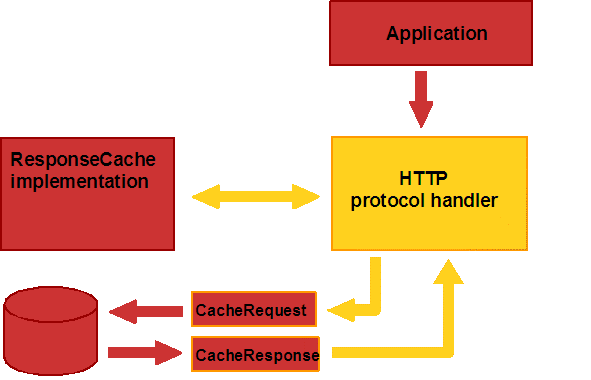URLConnection caching API
HTTP is typically used for distributed information systems, where performance can be improved by the use of response caches. While HTTP proxy servers normally caches recently visited web resources, it is sometimes also desirable to have a local cache. Examples are browser caches.
In Tiger, a new framework provides a way for protocol handlers to access a response caching mechanism implemented by the platform or by a third party.
Here is the API:
We have introduced three abstract classes in the java.net package. They are:
- ResponseCache
- CacheRequest
- CacheResponse
A concrete subclass of ResponseCache represents the URLConnection cache itself. An instance of such a class can be registered with the system by calling ResponseCache.setDefault(), and the system will call this object in order to:
- store resource data which has been retrieved from an external source into the cache;
- try to fetch a requested resource that may have been stored in the cache.
ResponseCache has two methods: get() returns a CacheResponse based on URI and request headers; and put() allows cache to decide if resource should be cached, returns a CacheRequest.
A concrete subclass of CacheRequest is used to write an entry in the ResponseCache. Instances of such a class provide an OutputStream object which is called by protocol handlers to store the resource data into the cache, and also an abort() method which allows a cache store operation to be interrupted and abandoned.
CacheRequest class has two methods: getBody() returns a stream for writing the request body into cache; and abort() abandons a cache write.
A concrete subclass of CacheResponse returns an entry from the ResponseCache. Instances of such a class provide an InputStream that returns the entity body, and also a getHeaders() method which returns the associated response headers.
CacheResponse class has two methods: getBody() returns a stream for reading the request body from cache; and getHeaders() returns the headers stored.

The following example shows a simple file based caching. However, it is equally viable to use other mechanisms such as a database for caching.
MyCacheResponse class is an implementation of CacheResponse. What it does is to take a file name and retrieve the HTTP response headers and body from it.
class MyCacheResponse extends CacheResponse {
FileInputStream fis;
Map<String, List<String>> headers;
public MyCacheResponse(String filename) {
try {
fis = new FileInputStream(new File(filename));
ObjectInputStream ois = new ObjectInputStream (fis);
headers = (Map<String, List<String>>) ois.readObject();
} catch (IOException ex) {
// handle exception
}
}
public InputStream getBody() throws IOException {
return fis;
}
public Map getHeaders() throws IOException {
return headers;
}
}
MyCacheRequest is an implementation of the CacheRequest. It takes a filename and the response headers and stores the headers in the file and also returns an outputstream directed to the same file so that any response body can be cached there.
class MyCacheRequest extends CacheRequest {
FileOutputStream fos;
public MyCacheRequest(String filename,
Map<String, List<String>> rspHeaders) {
try {
File file = new File(filename);
fos = new FileOutputStream(file);
ObjectOutputStream oos = new ObjectOutputStream(fos);
oos.writeObject(rspHeaders);
} catch (Exception ex) {
throw new RuntimeException(ex.getMessage());
}
}
public OutputStream getBody() throws IOException {
return fos;
}
public void abort() {
// we abandon the cache by close the stream,
// and delete the file
fos.close();
file.delete();
}
}
Finally, we can tie it altogether with our implementation of the ResponseCache, it checks the URI for the network resource that is being retrieved or to be cached and returns the appropriate instantiations of our implementations of CacheResponse or CacheRequest. In this example, we only handles the case when the URI is equal to uri1 for retrieving from the cache, and for URI equals uri2 for storing to the cache. But it is easily expanded to handle a more complicated file based cache.
class MyResponseCache extends ResponseCache {
public CacheResponse
get(URI uri, String rqstMethod, Map rqstHeaders)
throws IOException {
// get the response from a cached file if available
if (uri.equals(ParseUtil.toURI(uri1))) {
return new MyCacheResponse(FNPrefix+"file1.cache");
}
return null;
public CacheRequest put(URI uri, URLConnection conn)
throws IOException {
// save cache to a file
// 1. serialize headers into file2.cache
// 2. write data to file2.cache
if (uri.equals(ParseUtil.toURI(uri2))) {
return new MyCacheRequest(OutFNPrefix+"file2.cache",
conn.getHeaderFields());
}
return null;
}
}
Once we have developed our own ResponseCache implementation, all left to be done is to register it and the JVM will use it.
public static void main(String args[]) throws Exception {
......
ResponseCache.setDefault(new MyResponseCache());
HttpURLConnection http = (HttpURLConnection)url1.openConnection();
InputStream is = null;
......
}
There is no default implementation of URLConnection caching in the Java 2 Standard Edition. However, Java Plugin and Java WebStart do provide one out of the box.
